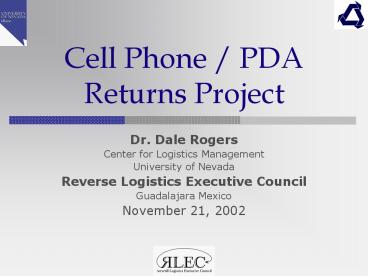Cell Phone PDA Returns Project - PowerPoint PPT Presentation
1 / 15
Title:
Cell Phone PDA Returns Project
Description:
Cell Phone / PDA Returns Project. Dr. Dale Rogers. Center for Logistics Management ... U.S. Cell phone use has grown dramatically. 340,000 subscribers in 1985 ... – PowerPoint PPT presentation
Number of Views:82
Avg rating:3.0/5.0
Title: Cell Phone PDA Returns Project
1
Cell Phone / PDA Returns Project
- Dr. Dale Rogers
- Center for Logistics Management
- University of Nevada
- Reverse Logistics Executive Council
- Guadalajara Mexico
- November 21, 2002
2
Wireless Handset Returns
- Purpose of Study
- Current Issues
- Survey Data
- Future Issues
3
The Market
- U.S. Cell phone use has grown dramatically
- 340,000 subscribers in 1985
- over 128 million in 2001
- Introduction of new technology
- - PDAs, Smart phone, advance cell phone
features - - Technology/Multiple Systems/Platforms
4
Complicated by
- Sold as a Bundled Unit high-tech product bundled
with a service - Multiple Business Models
- Multiple Sales Channels
- Multiple Return/Repair Models
- Multiple Channel Player Motivations
- No Clear Benchmarkmarket still in flux
- This is a problem of millions of transactions of
low dollar value
5
Standard Practice
- Customer returns a handset the retail outlet
where it was purchased - Standard practice give customer a replacement
phone and send the questionable unit back to the
manufacturer or a third party for testing and
repair - BUT phone often turned out to be a "no trouble
found" (NTF) phone - Service provider paid cost of the testing as well
as the costs related to shipping and handling of
the return, as well as the price of the
replacement phone
6
The Flow
- Insert Visio diagram here
7
Returnswhy so many?
- Overselling to Customers?
- Focus on preserving Service-subscription?
- Lack of support at Retail level?
- Product performance related issues? (Coverage,
dropping calls, etc) - Lack of customer training on new features?
- True design and manufacturing quality issues?
8
Motivating Factors
- Primary Motivation of Service Providers/CarriersG
rowth - Secondary Motivation Operational Efficiency
9
Contributing Factors
- Training
- Network performance
- Support programs
- Market perception
- Buyers remorse
- Manufacturing quality
10
The Cost of NTFs
Phone Repair Estimates U.S. Estimated Units
sold 2001 128 Million Average Units
Returned 15 Estimated Returns 19.2
Million Average NTF/NFF 50 Estimated NTF
Returns 9.6 Million Estimated Cost to Handle
Repair 35 / unit Estimated NTF Returns
Cost 336 Million
Based on an eEstimated range of 25-50 / unit
11
Preliminary Survey Results
- THIS SLIDE WILL NEED TO BE UPDATED WITH MOST
CURRENT STATS ON TUESDAY - Customer to Carrier/Retailer
- 13-15
- Customer to Retailer
- 17-20
- Retailer/Carrier to Manufacturer
- 90-95
12
What the Future Holds
- Rate of growth of wireless is decreasing
- Revenue from customers no longer will sustain the
business - Industry consolidation shakeout
- Interest turned from Growth to Operational
Efficiency
13
What is Needed
- Currenly there is no good way to file a claim
from Retail to Carrier and Carrier to
Manufacturer - Need for Software to manage the info around
repair activity and aggregate information into
knowledge - Inexpensively collecting info is the challenge
14
Mobile Screening Testing
- Examples Agilent (Sprint, Verizon), Willtek
(ATT) - Allows the Retail Store Level to
- Quickly identify NTF phones and keep these out of
the repair process saving unnecessary test and
handling costs - Understand history of a customer's phone to
better handle service problems on the spot. - Identify trends/models with history of problems
- Track trends through software and database
- Cost approximately 1000 per outletused at
Retail, Service Provider, and Repair Channels
15
Next Research Steps
- Develop Benchmark Model
- Report complete percentages
- Additional survey questions A,B,C





























